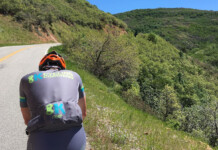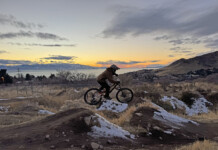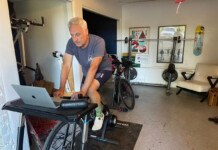Remember that the contact patch of each of your road bike tires is only the size of a postage stamp! Many say that the goal of good cornering is to maintain one’s velocity through a turn, which is true. It is important to keep in mind, however, that the supreme goal of cornering is to stay upright, especially when racing or descending at speed.
Steadily improve your ability and confidence while always maintaining a margin for error, especially where cars could play a role in a crash or accident, and you will enjoy descending and cornering while keeping the rubber side down.
Generally speaking, to corner confidently on a road bike, keep in mind these five fundamentals:
- Do any braking BEFORE you enter a turn
- Stay loose and light on your front end
- Lean your bike for traction and control
- Outside-Inside-Outside
- Know your wheels and tires
Setting up for it
It is important to establish your ideal, maintainable speed BEFORE entering a turn. Moderate your speed, i.e. do any necessary braking, beforehand.
You don’t want to obsess about the road right in front of you. Rather, focus on the entry and exit paths of upcoming curves, and in general on the stretch of road before you. This will allow you to optimally assess an approaching turn as well as a suitable speed given the overall situation – from changes in road surface, to lean of the road itself, to cars and other riders.
Braking while cornering will straighten your bike’s path of travel, changing your targeted line through the turn. It can also cause one of your tires to skid. Since front tire traction is your highest priority, avoid use of your front brake while cornering; you should only do so when absolutely necessary, and even then with great caution. If you do need to moderate speed while in a turn, do so by using your rear brake with a very light touch.
You will want to be in the drops of your handlebars with easy access to your brake levers. Keep your arms loose and elbows bent, almost as if your upper body acts as a suspension system to keep your front tire smoothly in contact with the road. Operative word here is smooth.
Finessing through it
You’ve heard about choosing a good line and hitting the apex just right. The apex is the innermost point of a turn. You want to choose a sweeping line that will allow you maintain your chosen speed for maximum control and efficiency.
Start wide (within your traffic lane and contingent upon the absence of cars!) then aim to hit the apex or inner edge of the turn as closely as you safely can. Finish the turn wide (within your lane leaving a margin for error!), carrying your sustained speed with the option to accelerate out of the turn.
The easiest way to remember and internalize this concept is simply: Outside-Inside-Outside.
Lean it like you mean it
A well known precept is to push down on your outer, extended pedal as you push on the inner drop of your handlebar. You want to control your bike, so that your bike doesn’t control you. In other words, it is often more important to lean the bike than lean the rider! Lean your bike more or less depending on your speed and the sharpness of a turn.
Generally, you don’t want to pedal through a turn. If you feel the need, such as in competition or to stay with other riders, do so with caution to ensure sufficient pedal /cornering clearance. Keep in mind that you and your bike are tilted at an angle. Depending on your speed and how aggressively you’re cornering, you may have less clearance than you realize.
Equipment matters
It is essential to be familiar with and confident in your equipment. Know your bike, wheels and tires. Don’t try anything fast or aggressive on a new configuration until you’re confident in each product’s ability to perform.
I know I can more aggressively push my speed through corners – especially on descents – when using trusted frames, wheels and tires. Unfamiliar or simply less sophisticated products do not afford a rider the same freedom. This is one reason why I don’t like the idea of “race day” products. Ride your best gear often. Don’t wait for the heat of battle to see what your gear is capable of; know before you go.
Embrace the rain
Given all of the rain we’ve experienced in recent weeks, it is worth noting that all of the above applies to an even greater degree when roads are wet. Any sudden movement or braking that disturbs a steady line through corners will significantly compromise traction. Give yourself plenty of time and berth to master wet weather riding, including familiarity with equipment – especially tires.
The ultimate rider is not only strong and fast: she or he is master of the situation and oh-so-smooth!
[Next issue we’ll look at cornering on a mountain bike.]












